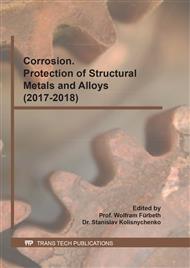p.260
p.266
p.272
p.278
p.283
p.289
p.295
p.299
p.305
Influence of the pH and Stirring Speed of the Electrodeposition Bath in the Performance of Zinc and Zinc-Nanocomposite Coatings
Abstract:
With the increase of environmental restrictions, chromium and cadmium-based coatings have been replaced by zinc layers. These coatings can be obtained through electrodeposition, whose industrially established pH range is from 5.0 to 5.8, and stirring speed is uncontrolled, which has led to part rejections. In addition, the corrosion resistance of zinc coatings is inferior to cadmium and chromium coatings, which has boosted the research of zinc composite coatings. The proposed work presents the performance of zinc-bentonite composite coatings in regards to corrosion relating to pH variation and stirring speed. The samples were degreased for 5 minutes in a commercial degreasing solution at a temperature of 55 °C, with magnetic stirring and, posteriorly, submitted to a pickling process with a duration of 1 to 2 minutes in a commercial bath, followed by a washing process with deionized water. The electrolyte used for electrodeposition was a zinc bath with a chemical composition of 85 g/l ZnCl2, 210 g/l KCl and 25 g/l H3BO3. For the zinc-bentonite electrodepositions 20 g/l of bentonite nanoparticles was added to the bath. Zinc and zinc-bentonite coatings were characterized by scanning electron microscopy, open circuit potential and potentiodynamic polarization. This work shows that a 5.2 pH is the most recommended for the zinc electrodeposition process. Potentiodynamic polarization tests indicated that pure zinc coatings developed in the stirring speed of 380 rpm and zinc-bentonite produced in the stirring speed of 710 rpm showed the best results.
Info:
Periodical:
Pages:
283-288
Citation:
Online since:
July 2017
Keywords:
Price:
Сopyright:
© 2017 Trans Tech Publications Ltd. All Rights Reserved
Share:
Citation:



